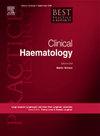双特异性t细胞接合疗法治疗多发性骨髓瘤
IF 2
4区 医学
Q3 HEMATOLOGY
引用次数: 0
摘要
前期使用以三胞胎和四胞胎为基础的方案,结合自体干细胞移植(ASCT)和维持性来那度胺,高比例的多发性骨髓瘤(MM)患者获得了深度和持久的应答。然而,骨髓瘤总是复发,在第一次复发时对一种或多种药物具有难治性。t细胞参与(TCE)疗法已经部分填补了这一治疗空白,该疗法在重度预治疗的MM患者中表现出显著的反应率和长期缓解,提供了现成的免疫治疗选择,导致美国食品和药物管理局(FDA)批准了三种双特异性TCE, teclistamab, elranatamab和talquetamab。我们回顾了TCE设计的最突出方面和MM治疗的临床经验。联合方法克服了抵抗机制,而早期使用TCE可以提高反应的深度和持久性。门诊增加剂量(SUD)进一步使社区采用。本文章由计算机程序翻译,如有差异,请以英文原文为准。
Bispecific T-cell engager therapy for multiple myeloma
With upfront use of triplet- and quadruplet-based regimens coupled with autologous stem cell transplant (ASCT) and maintenance lenalidomide, a high proportion of multiple myeloma (MM) patients are achieving deep and durable responses. Yet, myeloma invariably relapses, with refractoriness to one or more drugs at first relapse. This therapeutic gap has been partially filled by T-cell engager (TCE) therapies that have demonstrated remarkable response rates and prolonged remissions in heavily pretreated patients with MM, providing off-the-shelf immunotherapy options leading to the U.S. Food and Drug Administration (FDA) approval of three bispecific TCEs teclistamab, elranatamab, and talquetamab. We review the most salient aspects of TCE design and clinical experience in MM treatment. Combination approaches overcome resistance mechanisms, while earlier TCE use could enhance depth and durability of response. Outpatient step-up dosing (SUD) further enables community adoption.
求助全文
通过发布文献求助,成功后即可免费获取论文全文。
去求助
来源期刊
CiteScore
4.20
自引率
0.00%
发文量
42
审稿时长
35 days
期刊介绍:
Best Practice & Research Clinical Haematology publishes review articles integrating the results from the latest original research articles into practical, evidence-based review articles. These articles seek to address the key clinical issues of diagnosis, treatment and patient management. Each issue follows a problem-orientated approach which focuses on the key questions to be addressed, clearly defining what is known and not known, covering the spectrum of clinical and laboratory haematological practice and research. Although most reviews are invited, the Editor welcomes suggestions from potential authors.

 求助内容:
求助内容: 应助结果提醒方式:
应助结果提醒方式:


